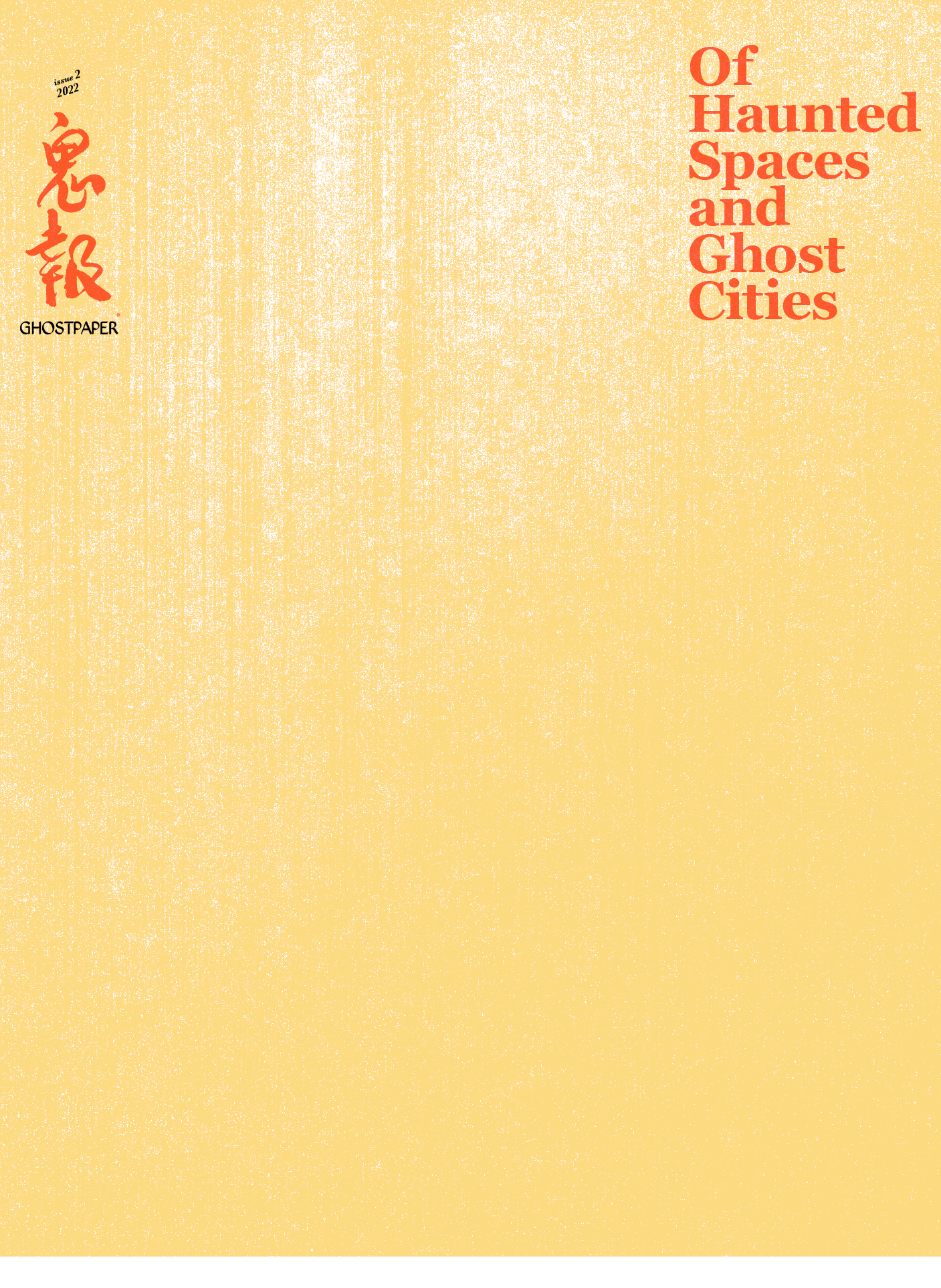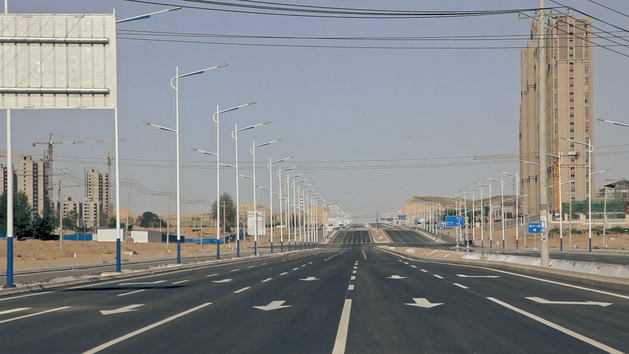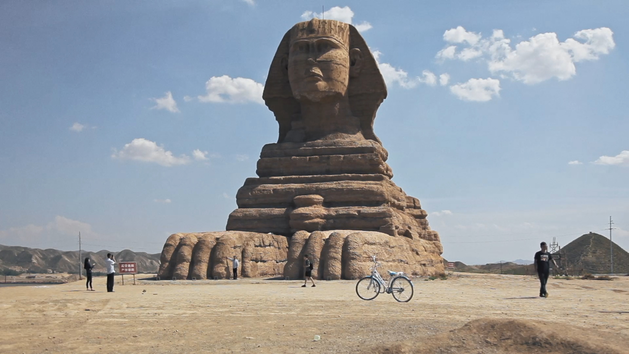I have been living in Taiwan for the past 20 years. My research in cinema as well as the inspiration for my filmmaking is focused on East and Southeast Asia. My interest in and curiosity for cultures and people has shown me the complexity of the geopolitical context of the world we live in and how it is determined by the processes and effects of globalization. Living in an environment that is characterized by rapid transformations made me attentive to these newly defined ‘other places’, which are haunted by the fantasy of the prosperous future, governed by the global urbanization in shifting cultures. Nowadays, these spaces are the secret path of our sociocultural logics. For this reason, the research Of Haunted Spaces is the sequel to my previous research and films, Subverses: China in Mozambique (2011), which investigates the Chinese settlement in Africa, and Double Happiness (2014), on the simulated culture and urbanism in China. The reproduced, other spaces are conceived as fanciful dream lands of perfect living, but these utopian lands never come alive. They remain unliveable, empty, deserted; as ghost-like as a 'u-topos' (οὐτόπος), a no-place.
In Of Other Spaces (1986) Foucault explained the taxonomy of the heterotopias, ranging from the illusory and contested to the inverted and the crisis. The visual mechanism of mirrors is described as the most different place per se, ‘through the real in the effect of a mirror image. The mirror exists, but the image in the mirror has no real space, it’s illusionary’ (Foucault 1997: 330). The juxtaposition of real and fake, site and non-site, contains, just like a theme park, all these different places in one small place. One needs to bear in mind that the other places deviating from the spatial norms can be called the subject of our times, much as the Lacanian mirror stage where the infants recognize themselves in the inverted images. The other places are fragments of the world—emerging right from the margin of the unnoticeable and functioning as time capsules of the anachronism of history—presenting the world in its diffused totality (Lacan 1949, 2021).
Today the urban space is haunted by fantasies and dreams offered by government, urban planning, and real estate advertisements, which together deliver the spectrum of living contemporary fairy tales. Urban spaces, once sites of continuing histories, are now displaced as non-sites capable of transporting one anywhere. Dwellers are regulated subjects, subsumed by the logics of the global urbanization, in subjugation rather than autonomy. In addition, they discover identity through the imagery experience, while advertisement, TV, and films actively promote an ideological mould that forms a unified mass (Braester 2010: 12). Much as the collective fantasy and desire are integral to power, although fostering a unifying dream is the property of fascism and totalitarian communism (Duncombe 2007: 3), this formula of control has never changed in global transnational capitalism. New urban spaces in the world are often the result of overwhelming delusions of grandeur and money laundering. Buildings are being pulled down; shapes of architectures are morphing; dwelling spaces are altering; consumer areas expand and assume a new face within a relatively short period of time, like plastic surgery by urbanization. The local histories can only collide; cultural identity can be branded; cities are built on no man’s land; the memories are forgotten or even rewritten. City planners are always in a hurry to replace the old with the new, the modern, and the cutting-edge. The rapid urbanization has erased the old structure of the cities. It is not only the drive of capitalism that forces city planners to erase the old, but it is also a decision made by the government to erase the memories of the past. In the case of Taiwan, these are the traces of colonialism; in China the effects of the Cultural Revolution.
“
The city is superficial and can produce every Monday morning a new identity, such as a Film studio in Hollywood.
”
—Rem Koolhaas
The mental effects of the erasure can hardly be measured. The celebration of the new always sacrifices the old. On the one hand, the newly erected cities are celebrated as liberation from the past and from the old identity. Asian cities are ‘Städte ohne Eigenschaften’ (Koolhaas & Mau 1998), sites without distinctive characteristics; as architect and theoretician Rem Koolhaas defines them, they are an escape from the identity and the burden of history. They have no history, though they are uncomplicated and can be renewed or expanded any time. ‘The city is superficial and can produce every Monday morning a new identity, such as a Film studio in Hollywood’ (1998: 1250). New identities can be produced and adapted from other places. The remaking of European-style cities is a common way to superimpose a ready-made identity, to create emotions of longing for and belonging to a fancy fantasyland. On the other side there are the filmmakers of the sinophone world struggling with the loss of traceable evidence of the past, the loss of the old, the missing architectural features as much as the destruction of the urban spaces. Yomi Braester phrases the phenomenon of urbanization as ‘monuments of the forgetting, a space of consumerism and speculation, a metropolis in the process of being demolished and reconstructed, a city that burns down and leaves room for neither personal memory nor collective identity’ (Braester 2010: 204).
The surface of the populated city has been expanded and raised skyward: not only the transformation from nature to the culturally urban, but also the gardening of concrete and glass in artificial landscape. Tourism, cinema, and image production contribute to boosting a mirage, a simulation of places other than the actual one. Reality becomes fiction. One can even attest to Stephen Duncombe’s quote that the texts of contemporary real estate are already scripted roles, ‘Today’s world is linked by media systems and awash with advertising images; political policies are packaged by public relations experts and celebrity gossip is considered news. More and more of the economy is devoted to marketing and entertainment or the performance of scripted roles in the service sector’ (Duncombe 2007: 3). As a result of spacing among cities, the living is radically juxtaposed with the dead; the consuming and the leisure activities are cluttered right in front of ramps, highways, and massive transport systems. Today’s urban spaces are full of newly formed heterotopias; ruins, theme parks, copied towns, settlements, and ghost towns are finding new expression in the contemporary world. Notably, in China, in the Arab world, and in Africa, we find the factories of the world, where governments are interested in investing regardless of the effects of unequal labour or environmental pollution, and the gap between rich and poor is huge.
The Chinese economy is more dependent on house building than other countries, and the market is huge. It is common for people in China to want to buy a house, as a form of social insurance and investment. Accordingly, the corruption in this economy sector is higher than anywhere else. Local governments rush to attempt to boost GDP growth and reach urbanization goals. To maintain high GDP growth, the government has to spend more; the more they build, the more the index increases. To build real estate and infrastructure is the easiest way to achieve the goal—this is a common investment in China, and 64 million apartments remain empty (Shelton et. al. 2018). As a result, massive cities, shopping malls, and theme parks are built without permanent residents. Ghost cities are a product of the global capitalist economy and can be seen as modernized ruins. To construct such real estate wasteland, the landscape is completely transformed into different shapes, such as in Boluo/Huizhou, where the mountains were divided and tapered to resemble the region of the Austrian alps where Hallstatt is located. Another giant-scale development can be found in the province of Shanxi, Lanzhou New Area, where hundreds of mountains were flattened to build cities. These ghost cities, which are growing in number in China, are haunted places, the product of a profusion of economic growth and an exorbitant real estate bubble. They are doomed as ruins, before they were ever alive. These haunted places created as dream places and fantasylands often remain defunct, void, empty, built with great effort to imagine a better future with luxury hotel complexes, gated communities, skyscrapers, and city halls of no man’s world. The new ghost towns are heterotopias, the promise of civilization halted and arrested, condemned to becoming ruins. They were once conceived as fanciful dream lands of perfect living, but this utopian dream can never come true. New ghost cities are the post-contemporary phenomena, the standard product of hyper-modernity only resulting in the excessive, revealing the exhaustion of modernization itself.
Using Ordos, a ghost town in Inner Mongolia, as the entry point for investigation, I intended to exorcize the haunted places from the spectre of global capitalism using films as the medium. New ghost cities in China serve as the doorway to reveal the ever-growing scales and economic dimension of the neoliberal market at its most extreme. China, the newcomer of capitalism and the rising power player, is affecting all parts of our lives on a global scale; meanwhile China experiences the most drastic changes in the sociocultural domain of everyday life due to economic factors. As market dynamics can be an aggressor to democratic systems, and economic growth comes before human rights and ecological awareness, it is essential to keep a close eye on what is happening in China as the mirror of the world. The complexity woven among biospheres can be demonstrated through art-based research, and the intertextual significance of exploring the enigmas of the Chinese ghost cities reveals the effect of cognitive capitalism.




